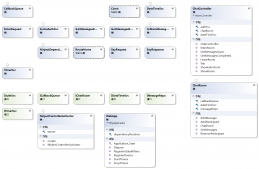以前在web端的身份认证都是基于Cookie | Session的身份认证, 在没有更多的终端出现之前,这样做也没有什么问题,但在Web API时代,你所需要面对的就不止是浏览器了,还有各种客户端,这样就有了一个问题,这些客户端是不知道cookie是什么鬼的。 (cookie其实是浏览器搞出来的小猫腻,用来保持会话的,但HTTP本身是无状态的, 各种客户端能提供的无非也就是HTTP操作的API)
而基于Token的身份认证就是应对这种变化而生的,它更开放,安全性也更高。
基于Token的身份认证有很多种实现方式,但我们这里只使用微软提供的API。
接下来的例子将带领大家完成一个使用微软JwtSecurityTokenHandler完成一个基于beare token的身份认证。
注意:这种文章属于Step by step教程,跟着做才不至于看晕,下载完整代码分析代码结构才有意义。
前期准备
推荐使用VS2015 Update3作为你的IDE
你需要安装.NET Core的运行环境以及开发工具
创建项目
在VS中新建项目,项目类型选择ASP.NET Core Web Application(.NET Core), 输入项目名称为CSTokenBaseAuth
Coding
创建一些辅助类
在项目根目录下创建一个文件夹Auth,并添加RSAKeyHelper.cs以及TokenAuthOption.cs两个文件
在RSAKeyHelper.cs中
|
1
2
3
4
5
6
7
8
9
10
11
12
13
14
15
|
using System.Security.Cryptography;namespace CSTokenBaseAuth.Auth{ public class RSAKeyHelper { public static RSAParameters GenerateKey() { using (var key = new RSACryptoServiceProvider(2048)) { return key.ExportParameters(true); } } }} |
在TokenAuthOption.cs中
|
1
2
3
4
5
6
7
8
9
10
11
12
13
14
15
|
using System;using Microsoft.IdentityModel.Tokens;namespace CSTokenBaseAuth.Auth{ public class TokenAuthOption { public static string Audience { get; } = "ExampleAudience"; public static string Issuer { get; } = "ExampleIssuer"; public static RsaSecurityKey Key { get; } = new RsaSecurityKey(RSAKeyHelper.GenerateKey()); public static SigningCredentials SigningCredentials { get; } = new SigningCredentials(Key, SecurityAlgorithms.RsaSha256Signature); public static TimeSpan ExpiresSpan { get; } = TimeSpan.FromMinutes(20); }} |
Startup.cs
在ConfigureServices中添加如下代码:
|
1
2
3
4
5
6
|
services.AddAuthorization(auth =>{ auth.AddPolicy("Bearer", new AuthorizationPolicyBuilder() .AddAuthenticationSchemes(JwtBearerDefaults.AuthenticationScheme) .RequireAuthenticatedUser().Build());}); |
完整的代码应该是这样
|
1
2
3
4
5
6
7
8
9
10
11
12
13
|
public void ConfigureServices(IServiceCollection services){ // Add framework services. services.AddApplicationInsightsTelemetry(Configuration); // Enable the use of an [Authorize("Bearer")] attribute on methods and classes to protect. services.AddAuthorization(auth => { auth.AddPolicy("Bearer", new AuthorizationPolicyBuilder() .AddAuthenticationSchemes(JwtBearerDefaults.AuthenticationScheme) .RequireAuthenticatedUser().Build()); }); services.AddMvc();} |
在Configure方法中添加如下代码
|
1
2
3
4
5
6
7
8
9
10
11
12
13
14
15
16
17
18
19
20
21
22
23
24
25
|
app.UseExceptionHandler(appBuilder => { appBuilder.Use(async (context, next) => { var error = context.Features[typeof(IExceptionHandlerFeature)] as IExceptionHandlerFeature; //when authorization has failed, should retrun a json message to client if (error != null && error.Error is SecurityTokenExpiredException) { context.Response.StatusCode = 401; context.Response.ContentType = "application/json"; await context.Response.WriteAsync(JsonConvert.SerializeObject( new { authenticated = false, tokenExpired = true } )); } //when orther error, retrun a error message json to client else if (error != null && error.Error != null) { context.Response.StatusCode = 500; context.Response.ContentType = "application/json"; await context.Response.WriteAsync(JsonConvert.SerializeObject( new { success = false, error = error.Error.Message } )); } //when no error, do next. else await next(); });}); |
这段代码主要是Handle Error用的,比如当身份认证失败的时候会抛出异常,而这里就是处理这个异常的。
接下来在相同的方法中添加如下代码,
|
1
2
3
4
5
6
7
8
9
10
11
12
13
14
15
16
17
18
19
20
21
22
23
24
25
26
27
|
app.UseExceptionHandler(appBuilder => { appBuilder.Use(async (context, next) => { var error = context.Features[typeof(IExceptionHandlerFeature)] as IExceptionHandlerFeature; //when authorization has failed, should retrun a json message to client if (error != null && error.Error is SecurityTokenExpiredException) { context.Response.StatusCode = 401; context.Response.ContentType = "application/json"; await context.Response.WriteAsync(JsonConvert.SerializeObject( new { authenticated = false, tokenExpired = true } )); } //when orther error, retrun a error message json to client else if (error != null && error.Error != null) { context.Response.StatusCode = 500; context.Response.ContentType = "application/json"; await context.Response.WriteAsync(JsonConvert.SerializeObject( new { success = false, error = error.Error.Message } )); } //when no error, do next. else await next(); });}); |
应用JwtBearerAuthentication
|
1
2
3
4
5
6
7
8
9
10
|
app.UseJwtBearerAuthentication(new JwtBearerOptions { TokenValidationParameters = new TokenValidationParameters { IssuerSigningKey = TokenAuthOption.Key, ValidAudience = TokenAuthOption.Audience, ValidIssuer = TokenAuthOption.Issuer, ValidateIssuerSigningKey = true, ValidateLifetime = true, ClockSkew = TimeSpan.FromMinutes(0) }}); |
完整的代码应该是这样
|
1
2
3
4
5
6
7
8
9
10
11
12
13
14
15
16
17
18
19
20
21
22
23
24
25
26
27
28
29
30
31
32
33
34
35
36
37
38
39
40
41
42
43
44
45
46
47
48
49
50
51
52
53
54
55
56
57
58
59
60
61
62
63
64
65
66
67
68
69
70
71
72
73
74
75
76
77
78
79
80
81
82
83
84
85
86
87
88
89
90
91
92
93
94
95
96
97
98
99
100
101
102
103
104
105
106
107
108
109
110
111
112
113
114
115
116
|
using System;using Microsoft.AspNetCore.Builder;using Microsoft.AspNetCore.Hosting;using Microsoft.Extensions.Configuration;using Microsoft.Extensions.DependencyInjection;using Microsoft.Extensions.Logging;using Microsoft.AspNetCore.Authorization;using Microsoft.AspNetCore.Authentication.JwtBearer;using CSTokenBaseAuth.Auth;using Microsoft.AspNetCore.Diagnostics;using Microsoft.IdentityModel.Tokens;using Microsoft.AspNetCore.Http;using Newtonsoft.Json;namespace CSTokenBaseAuth{ public class Startup { public Startup(IHostingEnvironment env) { var builder = new ConfigurationBuilder() .SetBasePath(env.ContentRootPath) .AddJsonFile("appsettings.json", optional: true, reloadOnChange: true) .AddJsonFile($"appsettings.{env.EnvironmentName}.json", optional: true); if (env.IsEnvironment("Development")) { // This will push telemetry data through Application Insights pipeline faster, allowing you to view results immediately. builder.AddApplicationInsightsSettings(developerMode: true); } builder.AddEnvironmentVariables(); Configuration = builder.Build(); } public IConfigurationRoot Configuration { get; } // This method gets called by the runtime. Use this method to add services to the container public void ConfigureServices(IServiceCollection services) { // Add framework services. services.AddApplicationInsightsTelemetry(Configuration); // Enable the use of an [Authorize("Bearer")] attribute on methods and classes to protect. services.AddAuthorization(auth => { auth.AddPolicy("Bearer", new AuthorizationPolicyBuilder() .AddAuthenticationSchemes(JwtBearerDefaults.AuthenticationScheme) .RequireAuthenticatedUser().Build()); }); services.AddMvc(); } // This method gets called by the runtime. Use this method to configure the HTTP request pipeline public void Configure(IApplicationBuilder app, IHostingEnvironment env, ILoggerFactory loggerFactory) { loggerFactory.AddConsole(Configuration.GetSection("Logging")); loggerFactory.AddDebug(); app.UseApplicationInsightsRequestTelemetry(); app.UseApplicationInsightsExceptionTelemetry(); #region Handle Exception app.UseExceptionHandler(appBuilder => { appBuilder.Use(async (context, next) => { var error = context.Features[typeof(IExceptionHandlerFeature)] as IExceptionHandlerFeature; //when authorization has failed, should retrun a json message to client if (error != null && error.Error is SecurityTokenExpiredException) { context.Response.StatusCode = 401; context.Response.ContentType = "application/json"; await context.Response.WriteAsync(JsonConvert.SerializeObject( new { authenticated = false, tokenExpired = true } )); } //when orther error, retrun a error message json to client else if (error != null && error.Error != null) { context.Response.StatusCode = 500; context.Response.ContentType = "application/json"; await context.Response.WriteAsync(JsonConvert.SerializeObject( new { success = false, error = error.Error.Message } )); } //when no error, do next. else await next(); }); }); #endregion #region UseJwtBearerAuthentication app.UseJwtBearerAuthentication(new JwtBearerOptions { TokenValidationParameters = new TokenValidationParameters { IssuerSigningKey = TokenAuthOption.Key, ValidAudience = TokenAuthOption.Audience, ValidIssuer = TokenAuthOption.Issuer, ValidateIssuerSigningKey = true, ValidateLifetime = true, ClockSkew = TimeSpan.FromMinutes(0) } }); #endregion app.UseMvc(routes => { routes.MapRoute( name: "default", template: "{controller=Login}/{action=Index}"); }); } }} |
在Controllers中新建一个Web API Controller Class,命名为TokenAuthController.cs。我们将在这里完成登录授权
在同文件下添加两个类,分别用来模拟用户模型,以及用户存储,代码应该是这样
|
1
2
3
4
5
6
7
8
9
10
11
12
13
14
15
|
public class User{ public Guid ID { get; set; } public string Username { get; set; } public string Password { get; set; }}public static class UserStorage{ public static List<User> Users { get; set; } = new List<User> { new User {ID=Guid.NewGuid(),Username="user1",Password = "user1psd" }, new User {ID=Guid.NewGuid(),Username="user2",Password = "user2psd" }, new User {ID=Guid.NewGuid(),Username="user3",Password = "user3psd" } };} |
接下来在TokenAuthController.cs中添加如下方法
|
1
2
3
4
5
6
7
8
9
10
11
12
13
14
15
16
17
18
19
20
21
|
private string GenerateToken(User user, DateTime expires){ var handler = new JwtSecurityTokenHandler(); ClaimsIdentity identity = new ClaimsIdentity( new GenericIdentity(user.Username, "TokenAuth"), new[] { new Claim("ID", user.ID.ToString()) } ); var securityToken = handler.CreateToken(new SecurityTokenDescriptor { Issuer = TokenAuthOption.Issuer, Audience = TokenAuthOption.Audience, SigningCredentials = TokenAuthOption.SigningCredentials, Subject = identity, Expires = expires }); return handler.WriteToken(securityToken);} |
该方法仅仅只是生成一个Auth Token,接下来我们来添加另外一个方法来调用它
在相同文件中添加如下代码
|
1
2
3
4
5
6
7
8
9
10
11
12
13
14
15
16
17
18
19
20
21
22
23
|
[HttpPost]public string GetAuthToken(User user){ var existUser = UserStorage.Users.FirstOrDefault(u => u.Username == user.Username && u.Password == user.Password); if (existUser != null) { var requestAt = DateTime.Now; var expiresIn = requestAt + TokenAuthOption.ExpiresSpan; var token = GenerateToken(existUser, expiresIn); return JsonConvert.SerializeObject(new { stateCode = 1, requertAt = requestAt, expiresIn = TokenAuthOption.ExpiresSpan.TotalSeconds, accessToken = token }); } else { return JsonConvert.SerializeObject(new { stateCode = -1, errors = "Username or password is invalid" }); }} |
该文件完整的代码应该是这样
|
1
2
3
4
5
6
7
8
9
10
11
12
13
14
15
16
17
18
19
20
21
22
23
24
25
26
27
28
29
30
31
32
33
34
35
36
37
38
39
40
41
42
43
44
45
46
47
48
49
50
51
52
53
54
55
56
57
58
59
60
61
62
63
64
65
66
67
68
69
70
71
72
73
74
75
76
77
78
79
80
81
82
|
using System;using System.Collections.Generic;using System.Linq;using System.Threading.Tasks;using Microsoft.AspNetCore.Mvc;using Newtonsoft.Json;using System.IdentityModel.Tokens.Jwt;using System.Security.Claims;using System.Security.Principal;using Microsoft.IdentityModel.Tokens;using CSTokenBaseAuth.Auth;namespace CSTokenBaseAuth.Controllers{ [Route("api/[controller]")] public class TokenAuthController : Controller { [HttpPost] public string GetAuthToken(User user) { var existUser = UserStorage.Users.FirstOrDefault(u => u.Username == user.Username && u.Password == user.Password); if (existUser != null) { var requestAt = DateTime.Now; var expiresIn = requestAt + TokenAuthOption.ExpiresSpan; var token = GenerateToken(existUser, expiresIn); return JsonConvert.SerializeObject(new { stateCode = 1, requertAt = requestAt, expiresIn = TokenAuthOption.ExpiresSpan.TotalSeconds, accessToken = token }); } else { return JsonConvert.SerializeObject(new { stateCode = -1, errors = "Username or password is invalid" }); } } private string GenerateToken(User user, DateTime expires) { var handler = new JwtSecurityTokenHandler(); ClaimsIdentity identity = new ClaimsIdentity( new GenericIdentity(user.Username, "TokenAuth"), new[] { new Claim("ID", user.ID.ToString()) } ); var securityToken = handler.CreateToken(new SecurityTokenDescriptor { Issuer = TokenAuthOption.Issuer, Audience = TokenAuthOption.Audience, SigningCredentials = TokenAuthOption.SigningCredentials, Subject = identity, Expires = expires }); return handler.WriteToken(securityToken); } } public class User { public Guid ID { get; set; } public string Username { get; set; } public string Password { get; set; } } public static class UserStorage { public static List<User> Users { get; set; } = new List<User> { new User {ID=Guid.NewGuid(),Username="user1",Password = "user1psd" }, new User {ID=Guid.NewGuid(),Username="user2",Password = "user2psd" }, new User {ID=Guid.NewGuid(),Username="user3",Password = "user3psd" } }; }} |
接下来我们来完成授权验证部分
在Controllers中新建一个Web API Controller Class,命名为ValuesController.cs
在其中添加如下代码
|
1
2
3
4
5
6
7
8
|
public string Get(){ var claimsIdentity = User.Identity as ClaimsIdentity; var id = claimsIdentity.Claims.FirstOrDefault(c => c.Type == "ID").Value; return $"Hello! {HttpContext.User.Identity.Name}, your ID is:{id}";} |
为方法添加装饰属性
|
1
2
3
4
5
6
7
8
9
10
11
12
13
14
15
16
17
18
19
20
21
22
23
24
25
26
|
[HttpGet][Authorize("Bearer")]完整的文件代码应该是这样using System.Linq;using Microsoft.AspNetCore.Mvc;using Microsoft.AspNetCore.Authorization;using System.Security.Claims;namespace CSTokenBaseAuth.Controllers{ [Route("api/[controller]")] public class ValuesController : Controller { [HttpGet] [Authorize("Bearer")] public string Get() { var claimsIdentity = User.Identity as ClaimsIdentity; var id = claimsIdentity.Claims.FirstOrDefault(c => c.Type == "ID").Value; return $"Hello! {HttpContext.User.Identity.Name}, your ID is:{id}"; } }} |
最后让我们来添加视图
在Controllers中新建一个Web Controller Class,命名为LoginController.cs
其中的代码应该是这样
|
1
2
3
4
5
6
7
8
9
10
11
12
13
|
using Microsoft.AspNetCore.Mvc;namespace CSTokenBaseAuth.Controllers{ [Route("[controller]/[action]")] public class LoginController : Controller { public IActionResult Index() { return View(); } }} |
在项目Views目录下新建一个名为Login的目录,并在其中新建一个Index.cshtml文件。
代码应该是这个样子
|
1
2
3
4
5
6
7
8
9
10
11
12
13
14
15
16
17
18
19
20
21
22
23
24
25
26
27
28
29
30
31
32
33
34
35
36
37
38
39
40
41
|
<html xmlns="http://www.w3.org/1999/xhtml"><head> <title></title></head><body> <button id="getToken">getToken</button> <button id="requestAPI">requestAPI</button> <script src="https://code.jquery.com/jquery-3.1.1.min.js"></script> <script> $(function () { var accessToken = undefined; $("#getToken").click(function () { $.post( "/api/TokenAuth", { Username: "user1", Password: "user1psd" }, function (data) { console.log(data); if (data.stateCode == 1) { accessToken = data.accessToken; $.ajaxSetup({ headers: { "Authorization": "Bearer " + accessToken } }); } }, "json" ); }) $("#requestAPI").click(function () { $.get("/api/Values", {}, function (data) { alert(data); }, "text"); }) }) </script></body></html> |
以上就是本文的全部内容,希望对大家的学习有所帮助,也希望大家多多支持服务器之家。
原文链接:http://www.cnblogs.com/onecodeonescript/p/6061714.html















